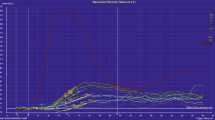Abstract
Prognosis of severe ischemic heart disease with no indication of percutaneous coronary intervention or coronary artery bypass grafting still remains poor. Extracorporeal shock wave therapy was introduced for medical therapy more than 20 years ago to break up kidney stones. We have demonstrated that extracorporeal cardiac shock wave therapy at a low level of ~10% of energy density that used for urinary lithotripsy treatment, effectively induces coronary angiogenesis and improves myocardial ischemia in a porcine model of chronic myocardial ischemia in vivo. On the basis of the promising results in animal studies, we have recently developed a new, non-invasive angiogenic therapy with low-energy shock waves for ischemic heart disease. Our extracorporeal cardiac shock wave therapy improved symptoms and myocardial ischemia in patients with severe coronary artery disease. These beneficial effects of the shock wave therapy persisted for at least 12 months. Importantly, no procedural complications or adverse effects were noted. These results indicate that our extracorporeal cardiac shock wave therapy is an effective and non-invasive treatment for ischemic heart disease. To further confirm the usefulness and safety of our SW therapy, we are currently conducting the second clinical trial in a randomized and placebo-controlled manner.
Similar content being viewed by others
References
Jessup M. and Brozena S. (2003). Heart failure. N. Engl. J. Med. 348: 2007–2018
Dimmeler S., Zeiher A.M. and Schneider M.D. (2005). Unchain my heart: the scientific foundations of cardiac repair. J. Clin. Invest. 115: 572–583
Forrester J.S., Price M.J. and Makkar R.R. (2003). Stem cell repair of infarcted myocardium: an overview for clinicians. Circulation 108: 1139–1145
Mathur A. and Martin J.F. (2004). Stem cells and repair of the heart. Lancet 364: 183–192
Nishida T., Shimokawa H., Oi K., Tatewaki H., Uwatoku T., Abe K., Matsumoto Y., Kajihara N., Eto M., Matsuda T., Yasui H., Takeshita A. and Sunagawa K. (2004). Extracorporeal cardiac shock wave therapy markedly ameliorates ischemia-induced myocardial dysfunction in pigs in vivo. Circulation 110: 3055–3061
Fukumoto Y., Ito A., Uwatoku T., Matoba T., Kishi T., Tanaka H., Takeshita A., Sunagawa K. and Shimokawa H. (2006). Extracorporeal cardiac shock wave therapy ameliorates myocardial ischemia in patients with severe coronary artery disease. Coron. Artery Dis. 17: 63–70
Uwatoku T., Ito K., Abe K., Oi K., Hizume T., Sunagawa K. and Shimokawa H. (2007). Extracorporeal cardiac shock wave therapy improves left ventricular remodeling after acute myocardial infarction in pigs. Coron. Artery Dis. 18: 397–404
Haupt G., Haupt A., Ekkernkamp A., Gerety B. and Chvapil M. (1992). Influence of shock waves on fracture healing. Urology 39: 529–532
Rompe J.D., Rumler F., Hopf C., Nafe B. and Heine J. (1995). Extracorporal shock wave therapy for calcifying tendinitis of the shoulder. Clin. Orthop. Relat. Res. 321: 196–201
Mariotto S., Cavalieri E., Amelio E., Ciampa A.R., Marlinghaus E., Russo S., Suzuki H. and Prati A.C. (2005). Extracorporeal shock waves: from lithotripsy to anti-inflammatory action by NO production. Nitric. Oxide. 12: 89–96
Maisonhaute E., Prado C., White P.C. and Compton R.G. (2002). Surface acoustic cavitation understood via nanosecond electrochemistry, part III: shear stress in ultrasonic cleaning. Ultrason Sonochem. 9: 297–303
Apfel R.E. (1982). Acoustic cavitation: a possible consequence of biomedical uses of ultrasound. Br. J. Cancer. 45(suppl): 140–146
Fisher A.B., Chien S., Barakat A.I. and Nerem R.M. (2001). Endothelial cellular response to altered shear stress. Am. J. Physiol. 281: L529–L533
Wang F.S., Wang C.J., Huang H.J., Chung H., Chen R.F. and Yang K.D. (2001). Physical shock wave mediates membrane hyperpolarization and Ras activation for osteogenesis in human bone marrow stromal cells. Biochem. Biophys. Res. Commun. 287: 648–655
Gotte G., Amelio E., Russo S., Marlinghaus E., Musci G. and Suzuki H. (2002). Short-time non-enzymatic nitric oxide synthesis from L-arginine and hydrogen peroxide induced by shock waves treatment. FEBS Lett. 520: 153–155
Seidl M., Steinbach P., Wörle K. and Hofstädter F. (1994). Induction of stress fibres and intercellular gaps in human vascular endothelium by shock-waves. Ultrasonics 32: 397–400
Asahara T., Murohara T., Sullivan A., Silver M., Li T., Witzenbichler B., Schatteman G., Isner J.M. and Zee R. (1997). Isolation of putative progenitor endothelial cells for angiogenesis. Science 275: 964–967
Rafii S. and Lyden D. (2003). Therapeutic stem and progenitor cell transplantation for organ vascularization and regeneration. Nat. Med. 9: 702–712
Millauer B., Wizigmann-Voos S., Schnürch H., Martinez R., Møller N.P., Risau W. and Ullrich A. (1993). High affinity VEGF binding and developmental expression suggest Flk-1 as a major regulator of vasculogenesis and angiogenesis. Cell 72: 835–846
Grunewald M., Avraham I., Dor Y., Bachar-Lustig E., Itin A., Jung S., Chimenti S., Landsman L., Abramovitch R. and Keshet E. (2006). VEGF-induced adult neovascularization: recruitment, retention, and role of accessory cells. Cell 124: 175–189
Ceradini D.J., Kulkarni A.R., Callaghan M.J., Tepper O.M., Bastidas N., Kleinman M.E., Capla J.M., Galiano R.D., Levine J.P. and Gurtner G.C. (2004). Progenitor cell trafficking is regulated by hypoxic gradients through HIF-1 induction of SDF-1. Nat. Med. 10: 858–864
Askari A.T., Unzek S., Popovic Z.B., Goldman C.K., Forudi F., Kiedrowski M., Rovner A., Ellis S.G., Thomas J.D., DiCorleto P.E., Topol E.J. and Penn M.S. (2003). Effect of stromal-cell-derived factor 1 on stem-cell homing and tissue regeneration in ischaemic cardiomyopathy. Lancet 362: 697–703
Aicher A., Heeschen C., Sasaki K., Urbich C., Zeiher A.M. and Dimmeler S. (2006). Low-energy shock wave for enhancing recruitment of endothelial progenitor cells: a new modality to increase efficacy of cell therapy in chronic hind limb ischemia. Circulation 114: 2823–2830
Auge B.K. and Preminger G.M. (2002). Update on shock wave lithotripsy technology. Curr. Opin. Urol. 12: 287–290
Roukis T.S., Weil L.S., Borrelli A.H. and Weil L.S. (2002). Extracorporeal shock wave therapy for the treatment of chronic plantar fasciitis: indications, protocol, intermediate results, and a comparison of results to fasciotomy. J. Foot Ankle Surg. 41: 166–172
Author information
Authors and Affiliations
Corresponding author
Additional information
Communicated by K. Takayama.
Rights and permissions
About this article
Cite this article
Shimokawa, H., Ito, K., Fukumoto, Y. et al. Extracorporeal cardiac shock wave therapy for ischemic heart disease. Shock Waves 17, 449–455 (2008). https://doi.org/10.1007/s00193-008-0122-5
Received:
Accepted:
Published:
Issue Date:
DOI: https://doi.org/10.1007/s00193-008-0122-5




